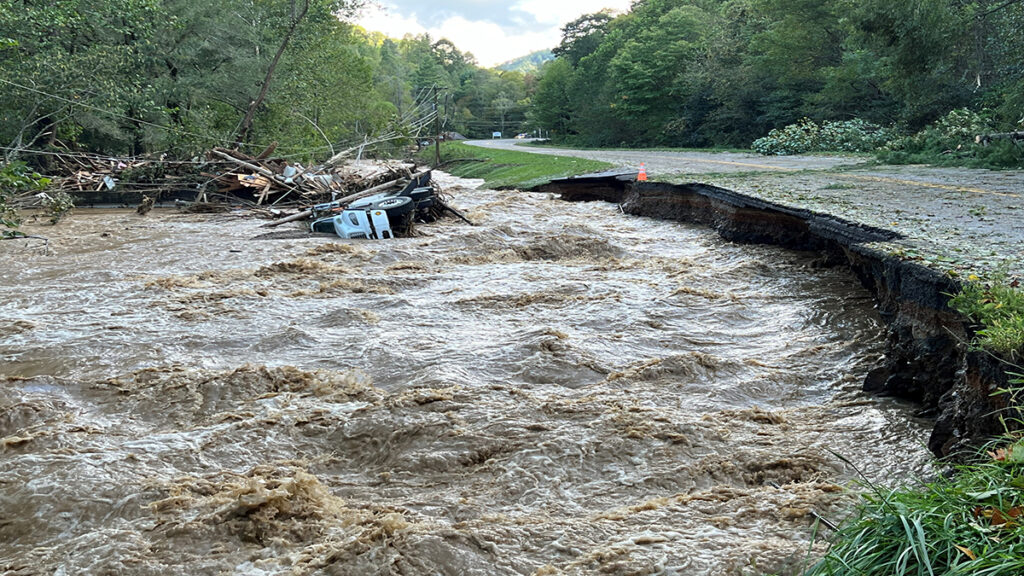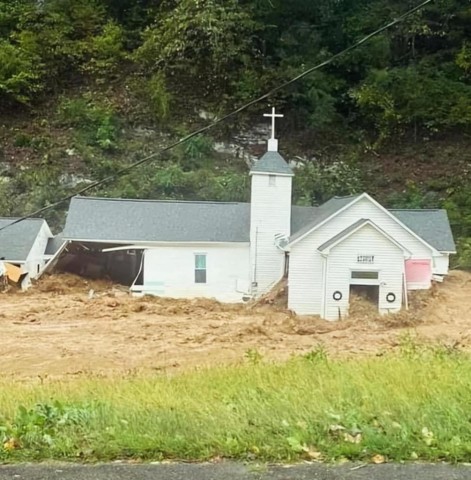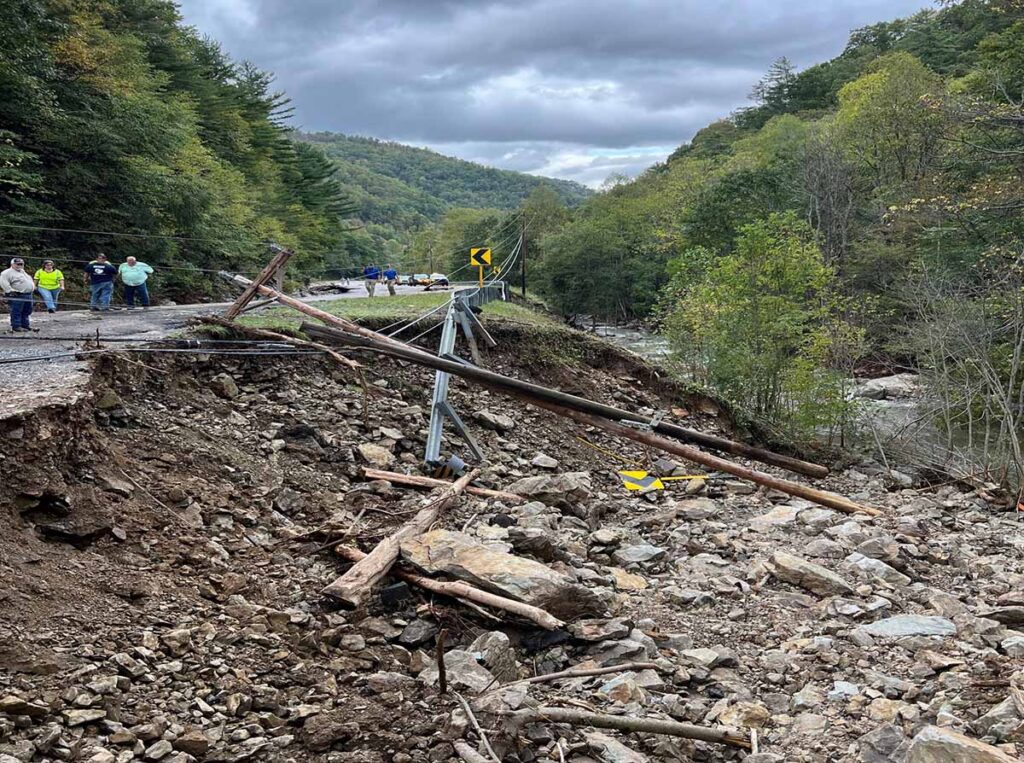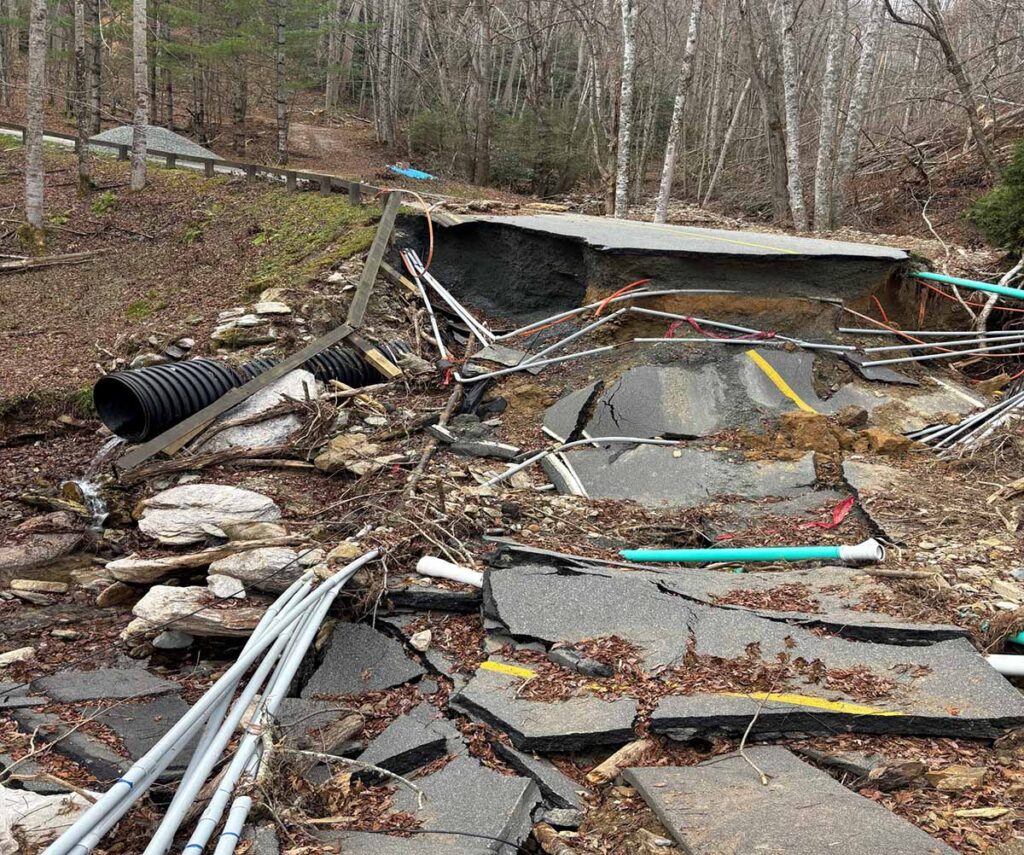
Editor’s note: Part Three of our series looks at how Hurricane Helene washed away roads, homes, churches and jobs at a cooperative that serves parts of Tennessee and North Carolina. Read Parts One and Two here.
Feb. 23, 2015, was a red-letter day in Mountain City, Tennessee, a polite city of about 2,500 tucked in the Blue Ridge Mountains near the North Carolina and Virginia borders. Parkdale Mills announced a $120 million plant expansion to produce spun yarn for high-grade inner and outerwear, creating 80 additional jobs and solidifying its role as an indispensable consumer of electricity and water.
The facility is empty now, a 400,000-square-foot husk in a dip along U.S. 421 as you exit Mountain City to the south. Last September, Hurricane Helene drowned Parkdale Mills beyond repair; employees abandoned cars in the flooded parking lot. Gone for good were 120 permanent jobs, considerable hourly work and a critical revenue base for the city and Mountain Electric Cooperative.
“Our largest manufacturer shut down. It’s going to impact us for years,” said Rodney Metcalf, general manager of Mountain Electric since 2023. “They had a 22-megawatt load plus all those employees. It’s a big loss of load and a big loss of income that’s going to accumulate year after year.”
Helene caused more widespread destruction to the electric cooperative system than any storm in history, putting 1.44 million members in the dark and leaving a trail of devastation and death that stretched from Florida to Kentucky.

In many cases, the pieces have been put back together, often painfully, and co-op lineworkers, staffers and members who lived through Helene can reflect on moments of kindness, sacrifice and bravery, instead of dwelling on the horrific.
There were more than a few moments of good will and resilience in the battle Mountain Electric Cooperative waged against the remnants of Helene. But they’re outweighed by the lasting aftershocks of a storm so fierce that it rerouted rivers and so sweeping that the Tennessee Valley Authority transported lineworkers via helicopter just to get to downed lines.
“I’ve been here for 21 years at TVA. We’ve never seen a storm like this,” said Chris Quillen, customer relations manager at TVA who works closely with Mountain Electric, the authority’s easternmost local power company.
“Typically, if you have a really, really bad storm, everybody’s got the power on safely in four or five days. When you’re talking about people being out of power for 30 days, that’s just unheard of.”
It shouldn’t flood here

What do you do if one of your co-op trucks is flipped on its side, thrashed by four feet of furious waters?
That’s the situation Mountain Electric found itself in. The truck was perched on the edge of a rural road with a hook securing a weakened pole. A creek-turned-rapids eroded the road and sent the truck and pole plummeting into the drink.
“It took three wreckers to get that truck out,” Metcalf said. “Wind, trees and rain are one thing, but the rushing water coming down out of the mountains, you just can’t do anything with it.”
Early indications put Helene’s path to the west of Mountain Electric, which serves about 36,600 members in the highland terrain of eastern Tennessee and western North Carolina. “We watched it for an entire week and we thought we’d get some wind out of it,” Metcalf said.
Wind, trees and rain are one thing, but the rushing water coming down out of the mountains, you just can’t do anything with it.
Rodney Metcalf, Mountain Electric Cooperative
On the morning of Sept. 27, while at a TVA meeting in Gatlinburg, Tennessee, Metcalf received pictures of major flooding in the co-op’s North Carolina territory. With new reports from the field, TVA swiftly opened its floodgates and implemented measures to counter rainfall 10 times the normal level; it estimated its actions saved about $406 million in potential damages.
“If they hadn’t opened them up when they did, it could have been a lot worse,” Metcalf said. But the damage was already done in Mountain Electric’s 700-square-mile service area. The rainfall was less than in some areas to the south, but the cumulative effect of water cascading down 4,000- and 5,000-foot elevations like Doe Mountain and Sugar Mountain spawned inland seas and altered the physical paths of the North Toe and other rivers.

A culvert near the co-op office clogged with debris; combined with rainfall, the area around the office in downtown Mountain City became a small lake. In the North Carolina community of Minneapolis, water rushing off a mountain turned a field for horses into a rocky river bottom; in a scene repeated many times during Helene, the watery onslaught claimed the lives of several horses.
A mudslide engulfed 82-year-old Antioch Baptist Church just south of Mountain City. Pastor Mike Fenner was out at the time and learned about it by text. “Sorry about the church,” it read. The church, which is working hard to rebuild on the same spot, is near a home where a husband pulled his wife, trapped in waist-high mud, to safety.

If you drive down remote roads, it is not uncommon to see people still living in their yards or with all their possessions outside their houses. No one in their right mind would buy flood insurance in one of the highest elevations in Tennessee and they lack the resources and the assistance to recover their losses. Metcalf is confident that Helene permanently washed away at least 150 homes and he knows at least six people who lost their land, their houses, their vehicles and their possessions.
“I’ve been in the industry for going on 41 years. So I worked a lot of hurricanes, tornadoes and ice storms,” Metcalf said. “This is probably the worst that I’ve ever seen. It was just areas that you never thought would flood.”
Picking up the pieces
A couple of weeks in, a representative of the Environmental Protection Agency approached Metcalf about securing soil samples near transformers. “The poles, the transformer, the wire, they may be in the lake, I don’t know. I have the GPS of where the transformers are located, the poles, but as you can tell, there’s not even any soil there,” Metcalf told him.
“And so that’s the kind of thing we’ve been working through.”
Part of the problem was that you couldn’t fix what you couldn’t see. Helene exacted a communications shutdown on Mountain Electric—no texts, no phone calls, no computers, not even its office-to-office radio system because power was out to all the repeaters. With an hourlong drive on a good day to its district in Newland, North Carolina, population 800, “it wasn’t just as easy as jumping in the truck, running over and seeing what they needed,” Metcalf said.

In addition, the majority of co-op lines were built from the 1950s to 1970s in dense woods and over ridges, hills and mountains. “It was challenging just to figure out how to get around to different places once the floodwaters receded. Then, working up there is very difficult,” Quillen said. “There were a lot of places where we couldn’t get vehicles or trucks to a particular spot.”
The answer was in the air. On Sept. 27, not long after the worst of the storm had passed, TVA helicopter pilot Jeffrey Wojtowicz and general foreman Mark Morrow flew over the Cranberry and Beech Mountain areas, part of Mountain Electric’s territory. In addition to trees on lines, four transmission towers were on the ground and four more needed repairs.
“We identified the problems in the Beech Mountain area in about three hours,” Wojtowicz said. “It would’ve taken multiple crews, multiple days to do the same thing.”
For about two weeks, TVA operated a helicopter station in a ski resort parking lot, shuttling workers to different substations and repair sites so they could cut trees off lines, and turning a grueling 30-minute drive up a mountainside into a quick 10-minute trip. “We would drop people in,” Morrow said. “We would load the chainsaws and everything that the line crew would need, come back, load it up and then fly it back out to the guys.”
In all, TVA sent nine crews to work on transmission line outages at Cranberry and Beech Mountain, including three line crews and two substation crews. Working nearly around the clock, crews reenergized transmission lines to three delivery points within a few days.
We would drop people in. We would load the chainsaws and everything that the line crew would need, come back, load it up and then fly it back out to the guys.
Jeffrey Wojtowicz, TVA helicopter pilot
By then, drawing on mutual aid and his relationships with contractors, Metcalf started bringing in reinforcements—about 200 workers divided between Tennessee and North Carolina by the beginning of the second week.
In one case, two crews toiled for nearly a week to rebuild a main feeder line near Mountain City after the storm swept away poles, lines and two lanes of a three-lane road. They constructed an angled pole and strung lines along the remaining side of the highway, a necessity since highway officials anticipated they needed two to three months to backfill the section where the poles once sat.
With few viable hotels in the area, some lineworkers headquartered in a fire hall and others stayed in vacant vacation rentals—Metcalf said that market is now a part of future disaster preparation plans. TVA coordinated deliveries of water and other materials at Mountain Electric’s warehouses and worked with community relief agencies.

“We had the entire agency behind the recovery on this,” Quillen said. “TVA has access to a lot of resources that not everybody has. It’s a matter of how we funnel the resources that we’ve got to help our local power companies do what they need to do to and get things back to normal as much as possible.”
In the end, Mountain Electric went through about 1,200 poles between its North Carolina and Tennessee territories. Helene damaged or destroyed about 325 transformers—25 kVA pad-mount transformers weigh 600 pounds or more. “We have no idea where some of them are at,” Metcalf said.
Overall, Metcalf said Mountain Electric is looking at more than $15 million in damage to its grid plus the loss of its largest manufacturer. But given the level of destruction, line crews made the best of a terrible situation, he said.
“I honestly didn’t think the power would be back on for two or three months.”
An uncertain future

What Helene wrought will be a financial challenge for years to come. Even with Parkdale Mills in operation, the U.S. Census Bureau identified Johnson County—Mountain City is the county seat—as a persistent poverty county, with rates of more than 20% for at least three decades. Almost one-quarter of its population is 65-plus, compared with 17.5% statewide.
The Mountain City Board of Aldermen upped water bills by 12% and sewer bills by 15% starting in April to make up for the loss of revenue from the yarn plant. A proposed Bitcoin mine would have generated a load of up to 30 megawatts for Mountain Electric and new revenue for the city and county. But amid local opposition, officials declined in August to approve a required rezoning, ending the bid for now.
“The labor force is not here and the roads for tractor and trailers are not conducive for a manufacturer to have something local,” Metcalf said. “We can turn to small businesses, but anything that’s got a lot of trucks running in and out, I just don’t see it happening.”
Metcalf is balancing the issue of higher rates and the squeeze they put on low-income households and business recruitment with the additional spending needed to maintain post-Helene rights of way. This year, tractor-trailers have been catching low-hanging lines from leaning poles, often telephone lines, and taking down the power with it, he said.
“There probably were a lot of trees that were weakened but didn’t fall and they are just waiting for storms this year. But if you try to clear it out to where no trees are going to fall, it’ll cost you millions of dollars,” he said. “We’re kind of between a rock and a hard place.”
Coming next week
In the next installment of our series, read how a comment over dinner kicked off a relationship that would see a South Carolina electric cooperative through its worst nightmare.
Contributing writer Steven Johnson is a former managing editor at NRECA, where he started in 2005, and former editor of Cooperative Living and vice president at the Virginia, Maryland & Delaware Association of Electric Cooperatives.
Banner Image Courtesy Mountain Electric Cooperative
